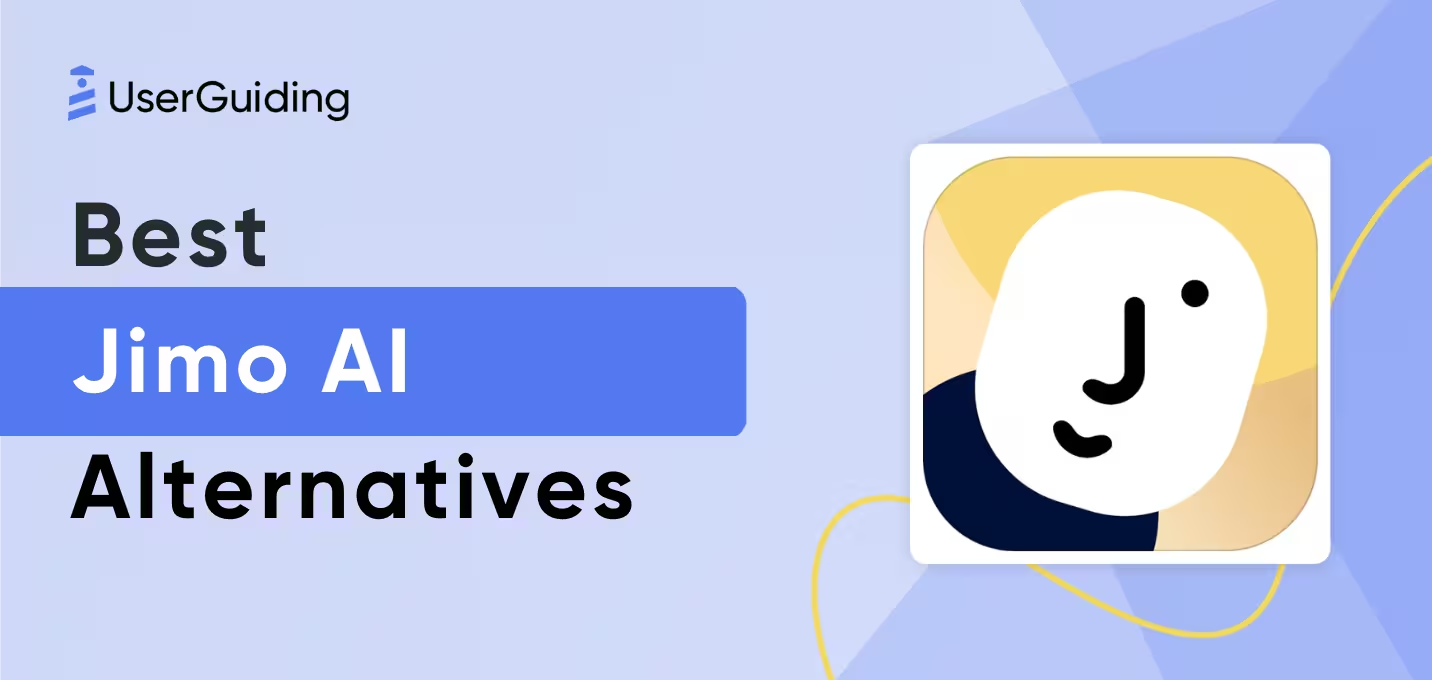

Imagine downloading a new app, eager to explore its features, only to abandon it after a single use.
Surprisingly, this is a common occurrence, with studies revealing that 25% of users discard an app after just one session.
However, there's a silver lining: effective user onboarding can significantly improve this scenario.
By providing a seamless and engaging introduction, companies can enhance user retention.
In fact, apps that implement a well-structured onboarding process have seen retention rates increase by up to 50%.
So, now you know what today’s article will be all about.
Stick around as we uncover the top user onboarding best practices for 2025—because a smooth start isn’t just nice to have, but it’s, indeed, absolutely necessary. 🚀
TL;DR
- User onboarding is the process of helping new users quickly understand and experience the value of your product. A well-structured onboarding process can boost retention rates by up to 50%.
- First impressions matter—a seamless onboarding experience ensures users feel confident and engaged from the start.
- Clear guidance is key—55% of users return products, and 80% delete apps because they don’t understand how to use them.
- A competitive edge—in a crowded market, a frictionless onboarding flow helps retain users and reduce churn.
- Avoid onboarding mistakes—email verification roadblocks and excessive steps can frustrate users and lead to abandonment.
- Focus on the ‘why’—instead of just explaining features, show how they improve users’ lives.
- Collaboration is essential—teams should work together to streamline the onboarding process and remove unnecessary friction.
What Is User Onboarding?
User onboarding is the process of guiding new users to understand and experience the value of your product or service.
It's like rolling out a welcome mat, ensuring users feel comfortable and confident as they begin their journey with your offering.
Effective user onboarding is crucial.
Studies show that 86% of people say they’d be more likely to stay loyal to a business that invests in onboarding content that welcomes and educates them after they’ve bought.
Moreover, a well-structured onboarding process can significantly boost user retention rates.
Organizations with a standard onboarding process experience 50% greater new hire retention, for one.
In essence, user onboarding is your opportunity to make a lasting first impression, ensuring users not only understand your product but also see its value in their lives.
Why Is User Onboarding Important?
User onboarding is more than just a welcome screen—it’s the key to making a great first impression, standing out in a competitive market, and ensuring long-term user retention.
Here’s why it matters:
#1 First Impressions Set the Tone

Imagine signing up for a new platform and being ✨immediately✨ greeted with an intuitive walkthrough, highlighting exactly how to get started.
Now, compare that to an empty dashboard with no guidance. 🫣
Which experience would make you stick around?
🚀A smooth onboarding process ensures users feel confident, reducing frustration and increasing engagement from the start.
#2 It’s Hard To Stand Out In A Crowded Market
With so many products fighting for attention, a confusing onboarding experience can, and probably will, send users running before they even get started.
In fact, 55% of users have returned a product simply because they didn’t understand how to use it, and 80% have said that they have deleted an app for the same reason.
Sounds about fair, don’t you think?
A clear, engaging onboarding flow isn’t just a nice touch—it’s the difference between a user sticking around or abandoning your product altogether.
#3 The Best Investment For Your Tool and Users
I like to think of user onboarding as the first real handshake between a product and its users—it sets the tone for everything that comes next.
If people feel lost or frustrated early on, chances are they won’t stick around. But when a product makes things easy and welcoming from the start, users are much more likely to stay.
In fact, 86% of people say they’d stay loyal to a business that takes the time to educate and guide them after they sign up.
See?
That’s exactly what I’m talking about!
A great onboarding experience isn’t just helpful—it’s what turns new users into long-term fans.
18 Best User Onboarding Practices to Adopt
#1 Speak to the Right Users
Before you start throwing tips and recommendations at new users, take a step back and ask:
Who are they?
What do they need?

A one-size-fits-all approach won’t cut it—effective onboarding starts with understanding your audience.
By segmenting users based on their behavior, experience level, or goals, you can craft personalized journeys that actually make sense to them.
Twin Science did exactly that by leveraging UserGuiding’s segmentation feature to tailor onboarding experiences for different user groups.
Active users were introduced to AI tools, while newcomers were guided through essentials like creating a class or adding students.
The result?
A seamless, customized experience that made users feel right at home.
And here’s the kicker—by using UserGuiding’s no-code guides and segmentation tools, Twin Science saved over $10,000 on labor costs.
If you’re curious to learn more about how they pulled it off, keep an eye out for our full success story! 👈
Key Takeaways
✔️ Identify different user segments based on experience, needs, and goals.
✔️ Personalize onboarding flows instead of using a generic, one-size-fits-all approach.
✔️ Take inspiration from Duolingo, which tailors learning paths based on user proficiency.
✔️ Use tools like UserGuiding to create no-code, segmented onboarding experiences.
#2 Your Sign-Up Flow Can Make or Break User Engagement
I was listening to Ramli John’s podcast the other day, and something he said really stuck with me:
"You have just 7 minutes to hook new users and turn them into lifelong customers."
Seven minutes! That’s all the time you get to make a lasting first impression.
And if those precious minutes are spent making users fill out long, complicated sign-up forms, chances are, they’ll give up before even experiencing what your product can do.
This reminds me of something Wes Bush pointed out: Over 30% of required form fields are completely unnecessary.
That’s a lot of wasted time and friction.
The goal should be to get users into the product as quickly as possible—not overwhelm them with forms.
So, what’s the fix?
✨ Keep it simple. ✨
Ask for only what’s essential.

🏆 Use social sign-ins, progressive profiling, or a “skip for now” option to let users start exploring right away.

The faster they experience value, the more likely they are to stick around.
Key Takeaways
✔️ Keep sign-up forms short—only ask for what’s necessary.
✔️ Use social sign-ins or progressive profiling to minimize friction.
✔️ Aim to engage users within 7 minutes, as recommended by Ramli John.
✔️ Remove unnecessary fields—30% of them don’t add value.
#3 Good UX always pays back
Ever opened an app and felt paralyzed by too many choices?
You’re not alone.
When users are bombarded with buttons, menus, and pop-ups, they get overwhelmed—and that’s when they bounce.
Ramli John puts it perfectly in Onboarding Done Right:
“How do we reduce not just the distraction, but the options that they can do? Because there is the principle around having too many options… The more options there are, the more likely they are to take longer to respond—or worse, leave.”
Just wow.
That’s what I’m talking about.
When new users sign up, they don’t need to see everything at once.
Instead, minimize distractions and highlight the next step.
One great example for this is definitely Canva.
When you sign up, Canva doesn’t throw dozens of features at you.
Instead, they ask a simple onboarding question: "What will you be using Canva for?"

Based on your answer, they tailor your experience—whether you’re a student, business owner, or designer.
This removes distractions and guides users straight to their first quick win, whether it’s creating a social media post or a presentation.
🚀 This isn’t just about clean design—it’s about user psychology. The fewer obstacles in their way, the faster they’ll become engaged, loyal users.
Key Takeaways
✔ Reduce unnecessary choices and distractions.
✔ Help them reach their first success moment fast.
✔ A focused UX keeps users engaged and coming back.
#4 Make Onboarding Stick with Interactive Experiences
Let’s be real—nobody wants to sit through a boring onboarding process filled with walls of text. The best way to keep users engaged?

And trust me, the numbers back this up!
93% of marketers say interactive content is more effective at educating buyers than static content.
And here’s the kicker: Users spend 13 minutes engaging with interactive content, while static content holds their attention for just 8.5 minutes.
I’ve seen this play out in real life, too. According to UserGuiding’s Product Trends e-book, companies use an average of 15 interactive guides to onboard users.
Here’s a sneak peek from the e-book:

That’s not just a nice-to-have—it’s a must.
Without it, you’re making users work harder to understand your product, and that’s a fast track to losing them.
Take Opinew, for example.
They used UserGuiding’s interactive guides and boosted their activation rate by 10%.

Just by giving users a hands-on experience, they made onboarding smoother and way more effective. 🚀
Key Takeaways
✔️ Add interactive guides to keep users engaged longer.
✔️ Use at least 15 interactive guides in onboarding (like top companies do).
✔️ Replace static content with hands-on experiences.
✔️ Make onboarding smoother with interactive walkthroughs.
#5 Make Onboarding Fun: Turn Goals into Challenges
Nobody likes a boring to-do list.
But turn those tasks into challenges, rewards, and progress bars—suddenly, users are hooked.
That’s the power of gamification, and it’s not just a trend.
70% of the world’s top 2000 companies use gamification to boost productivity, and the market is set to hit $95.5 billion by 2030.
If it works for employees, why wouldn’t it work for users?
One of the best examples? Duolingo.
Ever noticed how their streaks, XP points, and leaderboards keep you coming back?

Now that’s gamification at its finest—turning learning into a daily challenge.
Grab, the ride-hailing app, does something similar by rewarding users with points and badges for completing rides and using different services.

🚀 When users feel a sense of accomplishment, they’re more likely to stick around. So, whether it’s through badges, progress tracking, or rewards, make onboarding feel like a game—and let users win.
Key Takeaways
✔️ Turn onboarding into a game with challenges, rewards, and progress bars.
✔️ Use streaks, points, and leaderboards to boost engagement.
✔️ Make tasks feel fun and rewarding, not like a to-do list.
✔️ Keep users coming back by tapping into psychological triggers like competition and achievement.
#6 Guide Users Through Multiple 'Aha!' Moments
I used to think onboarding was all about getting users to one big ‘Aha!’ moment—the point where they realize the value of your product.
But after reading Product-Led Onboarding by Ramli John and Wes Bush, I realized that’s only part of the story.
Turns out, there isn’t just one ‘Aha!’ moment—there are multiple!
Think about it: A user might have their first ‘Aha!’ when they complete the setup and see your product in action.
Then, another one when they discover a feature that makes their life easier.
⭐️ Ramli John puts it best when he says, "I hate the term ‘the Aha moment’ because it’s more of a journey than just one magical moment."
This really shifts the way we think about onboarding.
Instead of expecting users to reach a single 'Aha!' moment and instantly commit to the product, we should guide them through a series of discoveries.

Each of these moments builds upon the last, creating a natural progression that strengthens user engagement.
📣 A company that absolutely nails multiple Aha! Moments in onboarding?
Slack, hands down.
When I first signed up, I remember being dropped straight into a chat with Slackbot.

No overwhelming dashboard, no confusing menus—just a simple, friendly message waiting for me.
And that was my first Aha! moment: “Oh, this isn’t just another boring work tool—it actually feels easy and interactive.”
👉🏼 Then came the next one. I sent my first message, played around with it and suddenly realized: “Wait… this isn’t just for chatting, it actually helps me stay on top of things!”
👉🏼 And then, the real magic happened—I invited teammates, set up channels, and connected Slack to other tools.
Key Takeaways
✔️ Identify multiple Aha! Moments in your product—don’t rely on just one big realization.
✔️ Map out the user journey and pinpoint when and how users experience value.
✔️ Design onboarding to guide users through sequential Aha! Moments step by step.
✔️ Use in-app messaging, tooltips, and emails to reinforce key value discoveries.
#7 Keep Users Engaged with Progress Tracking

You know that feeling when you’re checking off items on a to-do list and feel like a productivity machine?
That’s exactly what a good onboarding checklist does for your users—it gives them small wins that keep them moving forward.
Speaking of a good onboarding checklist… Here’s one of them from yours truly.
.avif)
Instead of long, text-heavy manuals that overwhelm users, onboarding checklists like ours, focus on actionable steps.
👉🏼 As Ramli John and Laura Kluz put it in their research, “(...) should prioritize actions over information.”
The best onboarding experiences don’t just tell users what to do—they guide them through hands-on tasks that help them experience value.
Key Takeaways
✔️ Use checklists instead of long manuals to drive action.
✔️ Keep steps short and specific (avoid vague instructions).
✔️ Add progress indicators to boost motivation.
✔️ Celebrate small wins (like a confetti animation or a success message).
#8 Keep Your Users in the Loop—Always

Ever been inside an app and felt completely lost, like, “Where do I even click next?”
That’s exactly what you don’t want your users to experience.
The key? Contextual help.
Instead of making users dig through lengthy help docs or Google their way out of confusion, bring the guidance to them—right when and where they need it.
That’s where hotspots and tooltips shine.
I recently came across a post from Ramli John about Hotjar’s A/B test, where they tested different ways of introducing a new feature.
The result? Hotspots were the clear winner—beating out banners and other onboarding methods.
Why? Because they naturally ✨grab attention✨ without being disruptive.
And it makes sense!
No one wants to be bombarded with pop-ups the second they open an app.
But a subtle glowing dot? It sparks curiosity and nudges users in the right direction—without feeling forced.
⭐️ If you’re looking for a no-code way to add these interactive elements, UserGuiding has got your back.
With our tool, you can:
🤌🏼 Add hotspots to highlight new features.
🤌🏼 Create tooltips that pop up with just the right info at the right time.
🤌🏼 Build interactive guides so users never feel stuck.
Here’s a sneak peek of what that looks like:

Key Takeaways
✔ Use hotspots to introduce new features without overwhelming users.
✔ Keep tooltips short and sweet—nobody wants to read a novel while clicking a button.
✔ Test different approaches (like Hotjar did) to see what your users engage with most.
✔ Make guidance contextual—don’t dump all the info at once; show it when it's needed.
#9 Make It Personal—Because One-Size-Fits-None

Let’s be real—no one likes a generic experience.
Whether it’s a streaming service recommending your next binge-worthy show or an app remembering exactly where you left off, personalization makes everything smoother.
And when it comes to user onboarding, it's not just a nice-to-have—it’s a game-changer.
Here at UserGuiding, we’ve analyzed countless SaaS companies, and guess what?
They agree.
Our CEO, Osman Koç, ranks personalization as the third most effective user onboarding strategy.
He even points out that “about a third (31%) of companies” have already embraced it.
But why does it work so well?
Because when users feel like an app gets them, they’re way more likely to stick around.
⭐️ Aakash Gupta puts it best: “The biggest mistake teams make when improving onboarding is treating all users the same.”
And he’s right.
Not every user needs the same guidance—some might need a full walkthrough, while others just want a quick nudge in the right direction.
In one of his LinkedIn posts, he highlights that great personalization isn’t just about using a name—it’s about understanding user behavior and delivering what they need, when they need it.
Key Takeaways
✔ Ditch the one-size-fits-all approach and segment users based on roles or behaviors.
✔ Let users pick their own path by allowing them to skip or dive deeper when needed.
✔ Use dynamic messaging—even something as simple as a first-name greeting helps.
✔ Test different levels of personalization to see what makes your users engage more.
#10 Make User Feedback a Two-Way Street
Let’s be real—guessing what works in your onboarding is like throwing darts in the dark.
You need to hear from your users.
That’s why collecting feedback shouldn’t be an afterthought; it should be part of the experience from day one.
I remember listening to Andrew Michael on Delivering Value, and one thing that stuck with me was how he named surveys as one of the six key onboarding strategies.
He pointed out that the best companies don’t wait until the end of onboarding to ask for feedback—they do it before, during, and after.
It makes total sense.
👉🏼 You’re not just checking a box; you’re actively shaping the experience based on what real users need.
Tools like PandaDoc use simple microsurveys to check in with users after they complete onboarding.
For instance, a two-question pop-up appears, asking how well they understand the platform and what, if anything, feels confusing. 👇🏻

This is literally all it takes to get valuable insights without making users feel like they’re filling out a tax form.
Key Takeaways
✔ Collecting user feedback should be an ongoing process, not an afterthought; gather insights before, during, and after onboarding.
✔ The best companies actively shape their onboarding based on real user input, not just assumptions.
✔ Feedback loops ensure users aren’t just completing onboarding—they’re actually understanding and benefiting from it.
#11 Don't Disappear After Onboarding
It’s easy to think onboarding ends once users complete the initial setup, but that’s far from the truth.
⭐️ If anything, this is when the real relationship with your users begins.
Keeping them engaged after onboarding is just as crucial as guiding them through it.
One of the best ways to do this is through well-crafted onboarding emails.
Claire Suellentrop, in an episode of UI Breakfast, highlights how Bidsketch nails this by sending action-based onboarding emails.
She explains:
“(...) Ruben, the founder of Bidsketch, includes small action items in every email. By following them, users naturally get better at using the product.’’
I love this approach because it keeps users actively learning without overwhelming them.
Plus, behavior-based emails like these have been proven to work.
Ramli John and Laura Kluz’s 36 Best User Onboarding Examples also found that behavior-based emails effectively re-engage users with the product.
So, if you’re not using them yet, it’s time to start. 🥶
You can even try to add a little sprinkle of gamification in there, too.
Take The Glenlivet, for example—they use a fun quiz in their onboarding email to learn about their subscribers’ whisky preferences.


Another key aspect of post-onboarding success is removing friction.
Users will inevitably hit roadblocks—whether it's confusion about a feature or a lack of motivation to return.
The best thing you can do? Identify where they struggle and offer timely help.
This could be through in-app guidance, proactive support messages, or even simple reminders nudging them toward the next step.
Key Takeaways
✔️ Send action-driven onboarding emails that small, step-by-step actions that keep users engaged.
✔️ Re-engage users with personalized nudges based on their actions.
✔️ Find where users struggle and offer timely support to remove friction.
✔️ Provide continuous value so users don’t drop off.
#12 Make Help Easy to Find (Without the Wait)
No one wants to jump through hoops just to get a simple answer.
That’s why in-app resource centers and knowledge bases are so valuable.
They give users instant access to the help they need without the frustration of waiting for a response.
And it’s not just a nice bonus—it’s what users expect.
According to research by American Express, 60% of customers prefer self-service tools for simple tasks over talking to live support.
At UG, we’ve made sure users can find answers on their own terms with both a resource center:
and a knowledge base built right into the platform. 👇🏻
This means fewer support tickets, faster resolutions, and a much smoother experience.
Now, let’s take a look at how this works in action.

This gives users a place to find answers without needing to reach out for help, which is a win-win for both them and your support team.

GroveHR nailed their user support game with UserGuiding’s Resource Center, too.
See how they integrated a sleek, in-app help hub that lets employees access the info they need without leaving the platform? It's perfect.
Key Takeaways
✔ Eliminate wait times through in-app resource centers that provide instant answers.
✔ Empower users – 60% prefer self-service over live support.
✔ Reduce support tickets by using a knowledge base that minimizes repetitive inquiries.
✔ Enhance user experience to help boosting confidence and retention.
#13 Keep Onboarding Simple (as much as you can)

What works for one product might be completely unnecessary—or even frustrating—for another.
That’s because onboarding is all about context.
It changes based on what users need, what the business requires, and how familiar people already are with the product.
That’s why onboarding has to adapt to different factors.
👉🏼 First, there’s the user’s goal.
Are they here to solve a quick problem, or are they making a long-term investment in learning a tool?
👉🏼 Then, there are business and industry requirements—some products have legal or compliance-related onboarding steps that can’t be skipped.
👉🏼 User experience and skill level also play a huge role; tech-savvy users might want to explore on their own, while beginners might need more hand-holding.
👉🏼 And of course, product familiarity matters.
If it’s an entirely new kind of tool, onboarding has to do a lot more than just point out buttons—it has to show users why they should care in the first place.
The Three Types of Onboarding
No onboarding – Some products are so simple that users don’t need any guidance.
Think of a basic calculator app—you open it, and it just works.
But even in these cases, a small welcome message or tooltip can set expectations and improve UX.
The key is to keep it short and to the point—users should get just enough guidance to reach value quickly, without unnecessary friction.
This aligns with what Wes Bush highlights in a recent LinkedIn post: Over 30% of required onboarding steps are unnecessary and can be removed without harming the user experience.
He suggests reviewing every onboarding step and asking:
✔ Is this a must-have step?
✔ Can this be introduced later?
✔ Can we remove this step altogether?
Quick onboarding – Many tools fall into this category, where a short, guided walkthrough helps users get started without overwhelming them.
Canva, for example, introduces new users to its design tools with a few easy steps, just enough to get them going.

Complex onboarding – Some products, especially enterprise software, require in-depth training.
CRMs, project management platforms, or tools with deep customization options often need tutorials, webinars, or even dedicated onboarding specialists to help users get the most value.
Key Takeaways
✔ ️ Match onboarding to the complexity of your product—some need none, some need a little, and some need a lot.
✔️ Even when onboarding isn’t “needed,” a small introduction can improve user experience.
✔️ Keep things short and focused—no one likes unnecessary steps.
✔️ If a product requires heavy onboarding, make sure it’s well-structured and engaging.
#14 Try Incremental Onboarding
Let's talk about making onboarding a breeze for your users.
Instead of overwhelming them with everything at once, why not break it down into bite-sized stages?
This approach, known as incremental onboarding, allows users to gradually explore your product, accessing certain features immediately while unlocking others as they progress.
Wes Bush again advises:
"Don't walk your new users through your entire product. Instead, focus on helping them achieve a quick win in your product."
A great example of this in action is Wise.

They masterfully implement incremental onboarding by asking users for information only when it's necessary.
After a swift registration, users can access the app immediately.
Additional steps, like opening an account or making a transfer, are introduced as needed, making sure the process feels natural and not overwhelming.
Key Takeaways
✔ Break onboarding into stages to avoid overwhelming users.
✔ Help users achieve quick wins instead of a full product tour.
✔ Unlock features gradually as users progress.
✔ Minimize friction, as Wes Bush suggests, for a smoother experience.
#15 Make Good Use of Empty States
Empty states are often overlooked, but they play a crucial role in guiding users toward meaningful actions.
Instead of presenting users with a blank screen when they first land on your product's dashboard, you can use empty states to prompt them to take the next step and experience value faster.
💡 Ramli John and Laura Kluz, in their work 36 Best User Onboarding Examples, identified empty states as one of the 8 key findings of great onboarding experiences.
A well-designed empty state can turn a moment of confusion into motivation, helping users navigate their journey smoothly.
📢 Wes Bush highlights this in The Product-Led Playbook:
"Empty states are valuable when users first arrive on a product’s dashboard. Instead of leaving them with a blank screen, use this opportunity to guide them toward actions that bring them closer to experiencing real value."
✨ Notion is a great example of a company that nails the use of empty states.

When a new user logs into Notion for the first time, they don’t see a blank page.
Instead, Notion provides pre-filled templates, helpful tooltips, and prompts users to create their first note or database.
This reduces friction and gives users a clear next step, helping them experience value right away.
Key Takeaways
✔ Use empty states to guide users toward meaningful actions.
✔ Transform confusion into motivation with well-designed empty states.
✔ Prompt users with templates and clear next steps, like Notion does.
#16 Harmonize Different UX Elements

A great onboarding experience isn’t built on just one element—it’s a combination of several working in harmony.
Each UX element serves a purpose.
For example, tooltips are great for contextual guidance, but relying solely on them would make onboarding incomplete.
Instead, a well-balanced approach incorporates product tours, checklists, inline hints, and empty states to create a seamless journey.
Onboarding isn’t a single sequence—it consists of multiple stages.
That’s why incremental onboarding is key: breaking down long processes into digestible steps and avoiding overwhelming, multi-step tutorials.
📌 Our CEO, Osman Koc highlights this in his LinkedIn post, listing multi-layered onboarding as one of the top 5 user onboarding strategies.
By using diverse elements strategically, you can help users get value from your product faster.
Key Takeaways
✔ Mix UX elements by combining tooltips, product tours, and checklists for a balanced experience.
✔ Avoid one-size-fits-all since no single element can handle onboarding alone.
✔ Use incremental onboarding to break long processes into smaller steps.
✔ Keep it short and limit tutorials to five steps or less.
✔ Layer onboarding; don't forget that a multi-layered approach improves activation.
#17 Experience Your Own Onboarding—Then Improve It
When was the last time you went through your own onboarding process from start to finish?
If the answer isn’t recently, it’s time to take a step back and experience it like a new user would.
Seeing your onboarding firsthand helps you catch frustrating steps, unclear instructions, or moments where users might feel lost.
Maybe a tooltip appears at the wrong time, or a critical step feels too long—these are things you might not notice until you go through it yourself.
A/B testing different flows can reveal what works best, while metrics like abandonment rates and feature adoption show where users struggle.
Here’s an example:

ConversionLab leveraged A/B testing to refine Campaign Monitor’s PPC (pay-per-click) landing pages.
They focused on a critical factor—matching the verb on the landing page with the one in the user’s search query.
Their hypothesis suggested that this alignment would boost perceived relevance, ultimately leading to higher conversion rates.
To test this, they implemented Unbounce’s dynamic text replacement (DTR) feature, which allowed the landing page text to change dynamically based on the user’s search input.
By running an experiment comparing standard landing pages with DTR-enhanced ones, they observed a 31.4% increase in conversion rates, proving that personalized messaging significantly impacts user engagement and conversion.
Key Takeaways
✔ Walk through your onboarding and note where things feel off.
✔ Experiment with different flows to see what keeps users engaged through A/B tests.
✔ Keep an eye on drop-off rates, retention, and feature adoption.
✔ Small tweaks can make a big difference over time.
#18 Achieve It All With UserGuiding
After diving into these key onboarding strategies, you might be wondering—how do you actually implement all of this?
The good news is, UserGuiding makes it easy to create seamless, engaging onboarding flows without needing a developer.
✅ Build onboarding sequences fast – No coding required, just drag and drop.
✅ Combine multiple UX elements – Tooltips, checklists, modals, and product tours all in one place.

✅ Personalize onboarding – Show the right guides to the right users based on their journey.
✅ Analyze & optimize – Track engagement, identify friction points, and improve onboarding continuously.

Set-up takes just minutes, and before you know it, your onboarding will be guiding users like a pro.
Key Takeaways
✔️ Combine different UX elements for a smooth user journey.
✔️ Track user behavior and update onboarding based on real insights.
✔️ Make onboarding easy with UserGuiding for both users and your team—no coding needed!
3 Bad User Onboarding Strategies to Avoid
1. The Instant Excitement Killer: Email Verification Roadblocks
Ramli John points out that nothing kills a new user’s enthusiasm faster than the dreaded “Please verify your email” message.
Forcing users to complete verification before experiencing any value leads to unnecessary drop-offs.
Instead, he recommends delaying verification until users have had a chance to engage—just like SparkToro does—so they’re more invested in continuing.

2. Too Many Steps, Too Many Chances to Leave
According to Ramli John, every extra click, field, or page in onboarding is an opportunity for users to abandon your app.
That’s why he stresses the importance of vetting every step.
Ask yourself: Which steps are truly necessary upfront, and which can be delayed?
His recommended approach:
Map it out, vet each step, and collaborate across teams to create a frictionless experience.
3. Explaining What Instead of Why
Most product tours, as Ramli John notes, focus too much on what a product does instead of why it matters to users.
But people don’t care about features—they care about how those features improve ✨their lives. ✨
He advises using onboarding content to excite and inspire, showing users exactly how your product helps them succeed.
Freshdesk, for example, nails this by framing each step around its value to the user.

Conclusion
At the end of the day, great user onboarding is all about making your users feel welcome and confident from the start.
By keeping things clear, focusing on how your features make their lives better, and removing any bumps in the road, you’ll build trust and keep them coming back for more.
So, take the time to create a smooth onboarding experience—it’s a small effort that can lead to big results!
Want Something Extra?
- 📺 User Onboarding Best Practices for 2025 – A deep dive into onboarding strategies by our very own Serra.
- 🎧 User Onboarding Best Practices with Samuel Hulick, Casey Winters, Joanna Wiebe, Scott Belsky, and Shaun Clowes - This episode from Inside Intercom features industry experts discussing effective user onboarding strategies
- 🎧 Kalzumeus Podcast Episode 9: Customer Onboarding with Samuel Hulick - Samuel Hulick shares insights on optimizing SaaS user onboarding experiences.
Frequently Asked Questions
How can users improve onboarding?
The user alone won’t be willing to improve their onboarding process. It will be your job to make sure that the process is smooth enough for them to complete without friction. But don’t worry, it takes only 3-4 key things to turn any onboarding process into a butter-smooth one.
How do you design the best onboarding?
1- You do research about the user persona of your and your competitor's products.
2- You invest in UX, and you solely design for your target audience and not the whole market.
3- You never leave the customer alone in the product, you make sure that they have access to all help channels, and they enjoy using your product.

















.svg)
.svg)
.svg)
.svg)
.svg)

.svg)
.svg)












.svg)
.svg)




.png)
















